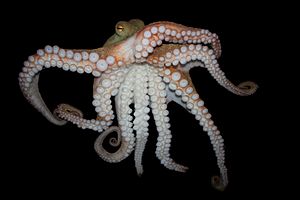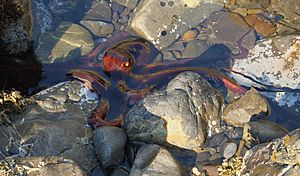Common New Zealand octopus facts for kids
Quick facts for kids Common New Zealand octopus |
|
|---|---|
 |
|
| Scientific classification | |
| Kingdom: | |
| Phylum: | |
| Class: | |
| Order: | |
| Family: |
Octopodidae
|
| Genus: |
Pinnoctopus
|
| Species: |
P. cordiformis
|
| Binomial name | |
| Pinnoctopus cordiformis (Quoy & Gaimard, 1832)
|
|
The Common New Zealand Octopus (scientific name: Pinnoctopus cordiformis) is a fascinating type of octopus. You can find it living around the coasts of New Zealand.
Contents
Meet the Common New Zealand Octopus
What Does It Look Like?
The Common New Zealand Octopus often has an orange-brown or purple-grey color. It also has shiny white spots on its arms and the web between them. You won't see these white spots on its main body, called the mantle.
These octopuses can grow quite large. Some have been seen over 1 meter (about 3 feet) long. They can also weigh up to 9 kilograms (about 20 pounds). However, it's rare to see them this big. This is because they usually live in deeper waters.
The Common New Zealand Octopus has a round head. This part holds its brain and other important body parts. It also has a mouth with a sharp, parrot-like beak. This beak helps it kill and eat its prey.
Amazing Octopus Abilities
The skin of this octopus is smooth. It can change color slightly to help it hide. This helps it sneak up on prey or avoid predators.
When an octopus feels threatened, it has a special defense. It can release a cloud of ink. This ink helps confuse predators, giving the octopus time to escape.
Octopuses have very good eyesight. Their eyes are much more developed than many other sea creatures. They are mostly active at night. They use clever tricks to find food and stay safe from danger.
How It Compares to Other Octopuses
The Common New Zealand Octopus is related to another species, Octopus huttoni. But it's easy to tell them apart. Octopus huttoni is much smaller, about the size of your fist.
The Common New Zealand Octopus has two rows of suckers on each arm. These suckers are opposite each other. Octopus huttoni only has one row of suckers on each arm.
Octopuses don't have any bones. This means they can squeeze into very small spaces. It also makes them hard to study. They can easily escape from fishing nets used for research.
Where Do These Octopuses Live?
Around the World
The Common New Zealand Octopus is mostly found in New Zealand. But they have also been seen off the coast of South Australia.
In New Zealand
This octopus is known as a reef octopus. In New Zealand, they live in many places. You can find them from Stewart Island in the south to areas near Leigh in the north. They also live around the Chatham Islands.
Their Favorite Homes
These octopuses can live in deep waters, up to 300 meters (about 980 feet) deep. But you can also find them in shallow waters near the coast. They often live on the sea floor. Sometimes, you might even spot them in shallow rock pools when the tide is out.
As they grow bigger, they move to deeper reefs. Here, they become important predators. They hunt and eat animals like crayfish, crabs, and shellfish. They also like to live in areas with seagrass and seaweed beds.
Life Story of the Octopus
The Common New Zealand Octopus has a fairly short life. Once they are fully grown, they find a mate. After mating, the male octopus dies.
The female octopus then lays her eggs. She stays in a safe den to protect them for about 80 days. During this time, she doesn't eat or leave the den. Just before the eggs hatch, the female leaves her den. She dies a short distance away.
A female Common New Zealand Octopus can lay a huge number of eggs. She might lay anywhere from 56,000 to 232,000 eggs! Other deep-sea octopuses, like Thaumeledone zeiss, lay only a few dozen eggs.
The eggs of the Common New Zealand Octopus are medium-sized. They are pear-shaped. When the eggs hatch, tiny octopus babies called paralarvae are released. These young octopuses can survive on their own right away.
Scientists haven't studied the lifespan of this octopus much. But it's thought they live for about 12 to 24 months. Their lifespan can depend on when they mate.
What Do They Eat?
The Common New Zealand Octopus is a skilled hunter. It pounces on its prey and wraps its arms around it. Then, it uses a special toxin from its saliva to paralyze the prey. After that, it uses its sharp beak to break up and eat the meal.
They often wait quietly near the entrances of caves or cracks in rocks. They wait for fish, crabs, shellfish, other octopuses, and other small sea creatures to pass by.
This octopus is strong enough to break open shellfish with its beak. It can also pull them apart to get to the soft animal inside.
Rock lobster and blue cod are two of their favorite foods. These octopuses sometimes get into fishing traps. They eat the catch before fishermen can collect it. In the spring of 1970, octopuses caused a big increase in deaths for blue cod and rock lobster in Hokianga.
Who Hunts the Octopus?
The Common New Zealand Octopus has many predators. This is a big reason why their population is not very large or spread out. Animals that hunt them include New Zealand sea lions, Buller's albatross, sharks, and whales.
Octopus in Māori Culture
A famous Maori legend tells the story of a Polynesian navigator named Kupe. He followed a giant octopus called Te Wheke-o-Muturangi. This huge octopus was eating all the fish that Kupe's tribe needed.
Kupe eventually found the octopus in the Cook Strait. He tricked it into holding some water containers. While the octopus was busy, Kupe struck it on the head and killed it.
In the past, early Māori people used to catch octopuses by hand. One hand would act as bait to attract the octopus. Then, the other hand would quickly grab and kill it.
Taxonomy
The scientific name Pinnoctopus cordiformis is sometimes considered the same as Octopus maorum. There isn't a specific original example (called a type specimen) for P. cordiformis. However, there seem to be real differences between octopuses identified as P. cordiformis and those called O. maorum. This suggests they might be two different species. Some experts think P. cordiformis might be more like a species from the genus Enteroctopus, especially Enteroctopus zealandicus. Because of this, some scientists consider the name Pinnoctopus cordiformis to be uncertain.


